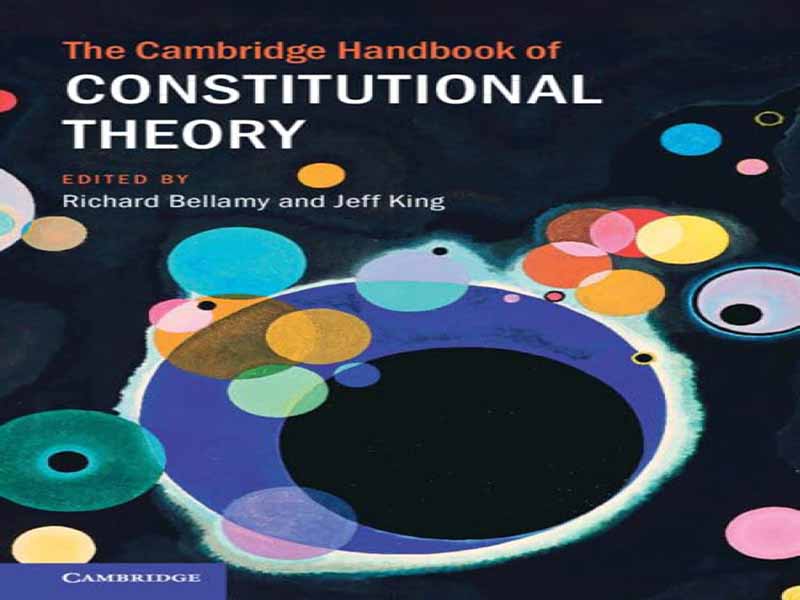- عنوان کتاب: The Cambridge Handbook of Constitutional Theory
- نویسنده: Richard Bellamy & Jeff King
- حوزه: قانون اساسی
- سال انتشار: 2025
- تعداد صفحه: 1256
- زبان اصلی: انگلیسی
- نوع فایل: pdf
- حجم فایل: 7.41 مگابایت
هیچ تعریف گسترده ای از “نظریه قانون اساسی” وجود ندارد. با این وجود، در ابتداییترین سطح، توصیفی، نظریه قانون اساسی، میتوان به عنوان استدلال یا تأملی نظری درباره نقش، ماهیت یا عملکرد ترتیبات عمومی قانون اساسی، اعم از حقوقی و سیاسی، در یک یا چند کشور در نظر گرفت. چنین استدلال یا تأملی را می توان به سه روش متمایز انجام داد که ما آن را نظریه قانون اساسی هنجاری، مفهومی و اثباتی می نامیم. نظریه قانون اساسی هنجاری عمدتاً مشتمل بر استدلال های هنجاری به نفع ترتیبات یا شیوه های خاص قانون اساسی است. شاخه ای از نظریه سیاسی کاربردی است. این نظریه قانون اساسی است زیرا استدلال ها معمولاً توجه دقیق تری به جزئیات نهادی قانون اساسی ارائه می دهند تا آنچه معمولاً در نظریه سیاسی مشاهده می شود.1 این نظریه قانون اساسی است زیرا استدلال های هنجاری غالباً به دنبال فراتر رفتن از نظم های سیاسی خاص هستند (یعنی استدلال ها میل به بی طرفی عاملیت دارند). به این معنا، نظریه قانون اساسی هنجاری از استدلالهای آشنا در قانون اساسی و سیاست متمایز است، که برای نتایج خاص – مانند نحوه تصمیمگیری در مورد یک مورد خاص – به ویژه دستورات قانون اساسی که ساختار متراکمی بر اساس هنجارها، اصول و کاربردهای ثابت شدهاند، مبارزه میکنند. نظریه مفهومی قانون اساسی استدلال هایی را درباره ماهیت عمیق ویژگی ها، نهادها و ایده های قانون اساسی ارائه می کند که معمولاً به عنوان حقایق مفهومی یا تبیینی به جای استدلال های هنجاری مطرح می شوند. ماهیت حاکمیت چیست و چه ارتباطی با ماهیت قانون دارد؟ ایالت چیست؟ قانون اساسی از چه نظر «قانون عالی» است؟ ویژگی های اساسی مجالس مقننه، دولت ها و قوه قضاییه چیست؟ قوه تشكيل دهنده چيست و چه ارتباطي با آنچه كه گاه قانونگذاري عادي و بالاتر ناميده مي شود چيست؟ مارتین لافلین این درک از نظریه قانون اساسی را زمانی نشان می دهد که می نویسد «اگر نظریه قانون اساسی یک تحقیق متمایز را تشکیل می دهد، باید هدفش شناسایی ماهیت ترتیبات قانونی موجود واقعی باشد» (لافلین 2005، ص 186). با این حال، لافلین به معنای ماهیت ترتیبات در یک کشور خاص نیست، منظور او اشاره به ترتیبات قانون اساسی در حداقل مجموعه وسیعی از کشورهایی است که ترتیبات سیاسی آنها اساساً متفاوت است (لافلین، 2005، ص 186). 1994 [1961]، ص. لافلین نقش نظریه قانون اساسی را «شناسایی سیستمی از اصول» یا «مجموعه ای از مفاهیم» مانند اختیارات، حقوق، حاکمیت، دولت، آزادی ها و غیره می داند. “وظیفه نظریه پرداز این است که … توضیحی در مورد ویژگی عمل ارائه دهد” (Loughlin 2005, p. 186). اگرچه این رویکرد به نظر توضیحی است، ما از آن به عنوان مفهومی یاد می کنیم. «توضیحات» نه جامعهشناختی هستند و نه تجربی به معنای دقیق. با این حال، سابقه طولانی کار اغلب عالی در این زمینه وجود دارد. برای در نظر گرفتن دو دشمن قدیمی، تعریف هانس کلسن (1967 [1960]، صفحات 286-320) از دولت بهعنوان یکپارچه در نظم حقوقی نمونهای خوب از نظریه مفهومی قانون اساسی است. به همین ترتیب، تلاش رقیب کارل اشمیت (2008 [1928]، صفحات 75-82) برای توصیف رابطه بین حاکمیت و قدرت قانونگذاری تشکیل شده است. در این مجلد، فصول مربوط به قدرت مؤسسه، قانون اساسی مادی و فدرالیسم را می توان نمونه های خوبی از آنچه ما نظریه مفهومی قانون اساسی می دانیم در نظر گرفت. چنین گزارشهایی مفهومی هستند زیرا نویسندگان ادعا میکنند که مفاهیم معانی ذاتی خاصی را در بر میگیرند، به طوری که استفاده از این اصطلاحات به روشهایی که با فرضیههای ادعایی آنها ناسازگار است، صرفاً از نظر هنجاری نادرست نیست، بلکه نشاندهنده سوء تفاهمی است که میتواند منطقاً با یک اشتباه دستهبندی اساسی برابری شود.
There is no widely adopted definition of ‘constitutional theory’. Nevertheless, at its most basic, descriptive, level, constitutional theory can be regarded as theoretical argument or reflection about the role, nature or practice of public constitutional arrangements, both legal and political, in one or more countries. Such argument or reflection can be carried out in three distinguishable ways, which we call normative, conceptual and positive constitutional theory. Normative constitutional theory consists chiefly of normative arguments in favour of particular constitutional arrangements or practices. It is a branch of applied political theory. It is constitutional theory because the arguments usually offer a closer attention to constitutional institutional detail than is commonly observed in political theory.1 It is constitutional theory because the normative arguments frequently seek to transcend particular political orders (i.e., the arguments aspire to agentneutrality). In that sense, normative constitutional theory is distinct from familiar arguments in constitutional law and politics, which contend for specific outcomes – such as how a particular case should be decided – in particular constitutional orders that are densely structured by settled norms, principles and usage. Conceptual constitutional theory presents arguments about the deep nature of constitutional features, institutions and ideas, typically put across as conceptual or explanatory truths rather than normative arguments. What is the nature of sovereignty, and how does it relate to the nature of law? What is a state? In what sense is constitutional law ‘higher law’? What are the essential characteristics of legislatures, governments and the judiciary? What is constituent power and what is its connection to what is sometimes called ordinary and higher-law making? Martin Loughlin exemplifies this understanding of constitutional theory when he writes that ‘[i]f constitutional theory is to form a distinct inquiry, it must aim to identify the character of actually existing constitutional arrangements’ (Loughlin 2005, p. 186). Loughlin does not mean, however, the character of arrangements in a particular country He means to refer to constitutional arrangements across at least a broad set of countries whose political arrangements differ fundamentally (Loughlin 2005, p. 186).2 His endeavour is comparable to that of H. L. A. Hart’s Concept of Law (1961), which the author famously described as an exercise in ‘descriptive sociology’ (Hart 1994 [1961], p. v). Loughlin considers the role of constitutional theory as being to ‘identify a system of postulates’ or ‘a set of concepts’ such as powers, rights, sovereignty, state, liberties and so on. It is ‘the job of the theorist to … offer an explanation of the character of the practice’ (Loughlin 2005, p. 186). Though this approach purports to be explanatory, we refer to it as conceptual. The ‘explanations’ are neither sociological nor empirical in any rigorous sense. Yet there is a long history of often excellent work in this vein. To take two old foes, Hans Kelsen’s (1967 [1960], pp. 286–320) definition of the state as entirely subsumed within and at one with the legal order is a fine example of conceptual constitutional theory. Likewise, so is Carl Schmitt’s (2008 [1928], pp. 75–82) rival attempt to describe the relationship between sovereignty and constituted law-making power. In this volume, the chapters on constituent power, the material constitution and federalism can be regarded as fine examples of what we consider to be conceptual constitutional theory. Such accounts are conceptual because the authors contend the concepts embody certain inherent meanings, such that usage of these terms in ways that are inconsistent with their alleged postulates are not simply unsound normatively but represent a misunderstanding that could be equated logically with a basic category mistake.
این کتاب را میتوانید از لینک زیر بصورت رایگان دانلود کنید:




































نظرات کاربران